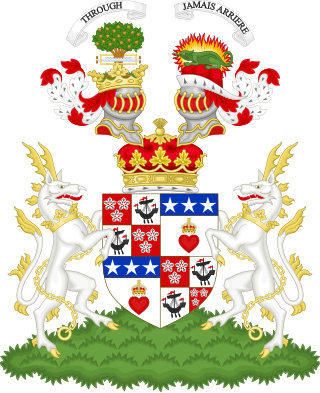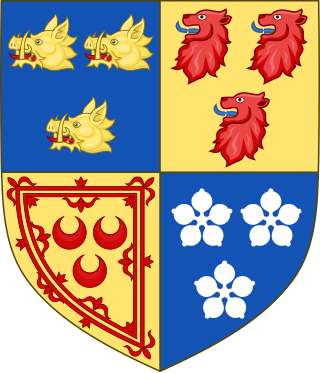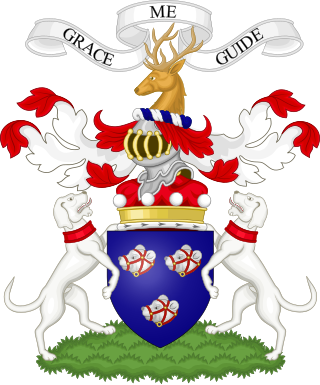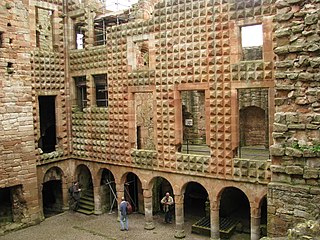Related Research Articles

The House of Stuart, originally spelled Stewart, was a royal house of Scotland, England, Ireland and later Great Britain. The family name comes from the office of High Steward of Scotland, which had been held by the family progenitor Walter fitz Alan. The name Stewart and variations had become established as a family name by the time of his grandson Walter Stewart. The first monarch of the Stewart line was Robert II, whose male-line descendants were kings and queens in Scotland from 1371, and of England, Ireland and Great Britain from 1603, until 1714. Mary, Queen of Scots, was brought up in France where she adopted the French spelling of the name Stuart.

Duke of Hamilton is a title in the Peerage of Scotland, created in April 1643. It is the senior dukedom in that peerage, and as such its holder is the premier peer of Scotland, as well as being head of both the House of Hamilton and the House of Douglas. The title, the town of Hamilton in Lanarkshire, and many places around the world are named after members of the Hamilton family. The ducal family's surname, originally "Hamilton", is now "Douglas-Hamilton". Since 1711, the dukedom has been held together with the Dukedom of Brandon in the Peerage of Great Britain, and the dukes since that time have been styled Duke of Hamilton and Brandon, along with several other subsidiary titles.
There are currently two earldoms of Mar in the Peerage of Scotland, and the title has been created seven times. The first creation of the earldom is currently held by Margaret of Mar, 31st Countess of Mar, who is also clan chief of Clan Mar. The seventh creation is currently held by James Erskine, 14th Earl of Mar and 16th Earl of Kellie, who is also clan chief of Clan Erskine.

The title Earl of Moray, Mormaer of Moray or King of Moray was originally held by the rulers of the Province of Moray, which existed from the 10th century with varying degrees of independence from the Kingdom of Alba to the south. Until 1130 the status of Moray's rulers was ambiguous and they were described in some sources as "mormaers", in others as "Kings of Moray", and in others as "Kings of Alba". The position was suppressed by David I of Scotland some time after his defeat of Óengus of Moray at the Battle of Stracathro in 1130, but was recreated as a feudal earldom by Robert the Bruce and granted to Thomas Randolph, 1st Earl of Moray in 1312.

Earl of Carrick is the title applied to the ruler of Carrick, subsequently part of the Peerage of Scotland. The position came to be strongly associated with the Scottish crown when Robert the Bruce, who had inherited it from his maternal kin, became King of Scots in the early 14th century. Since the 15th century, the title of Earl of Carrick has automatically been held by the heir apparent to the throne, thus the current holder of the title is Prince William, Duke of Rothesay.

William Cunningham, 9th Earl of Glencairn (1610–1664), was a Scottish nobleman, Lord Chancellor of Scotland, and a cavalier. He was also the chief of Clan Cunningham.
James Stewart, 1st Earl of Buchan (1442–1499) was a Scottish noble. He was the uncle of James III of Scotland who granted him the Earldom of Buchan. Buchan repaid his nephew by fighting for his cause against rebellious southern barons. Through his marriage to Margaret Ogilvy he acquired the title Lord Auchterhouse.

Clan Drummond is a Highland Scottish clan. The surname is rendered "Druimeanach" in modern Scottish Gaelic.
The baronetcy of Cuninghame of Corsehill was created in the Baronetage of Nova Scotia and conferred upon Alexander Cuninghame of Corsehill, a Scottish baron and landowner in Dumfriesshire and a great-great-great-grandson of the 4th Earl of Glencairn. The fourth baronet's father added the name Montgomery before his own on inheriting the estate of Kirktonholm.

Clan Cranstoun is a family of the Scottish Lowlands.

Clan Oliphant is a Highland Scottish clan.

Alexander Seton, 1st Earl of Huntly, who adopted the family name of Gordon from about 1457, was a powerful 15th-century Scottish magnate. He was knighted in 1439/1440 and was Lord of Badenoch, Gordon, Strathbogie and Cluny.
Sir Thomas Burnett of Leys, 3rd Baronet,, Lord Clerk Register, PC, MP. He was, at Stonehaven, 21 April 1664, retoured as heir to his father, Sir Alexander Burnett, 2nd Baronet who had died the previous year. The 3rd Baronet is the grandson of Sir Thomas Burnett, 1st Baronet, who completed the reconstruction of Muchalls Castle and the great-grandson of Alexander Burnett of Leys, who completed the construction of Crathes Castle.

Alexander Elphinstone, 1st Lord Elphinstone was a Scottish peer. He was the son of Sir John Elphinstone of that ilk and of Pittendreich.

Clan Stuart of Bute is a Highland Scottish Clan and is a branch of the larger Clan Stewart.

Clan Forbes is a Highland Scottish clan from Aberdeenshire, Scotland.

Francis Stewart, 5th Earl of Bothwell, was Commendator of Kelso Abbey and Coldingham Priory, a Privy Counsellor and Lord High Admiral of Scotland. He was a notorious conspirator who led several uprisings against his first cousin, King James VI, all of which ultimately failed, and he died in poverty in Italy after being banished from Scotland. Francis's maternal uncle, the 4th Earl of Bothwell, was the chief suspect in the murder of James VI's father, Lord Darnley.
William Cranstoun, 1st Lord Cranstoun was a Scottish Lord of Parliament, who played a prominent part in the pacification of the Anglo-Scottish border in the early 17th century.

William Hay, 10th Earl of Erroll PC was a Scottish nobleman.
James Lindsay, 7th Lord Lindsay PC, Scottish landowner who was a gentleman of King James's bedchamber.
References
- The Royal Families of England Scotland and Wales, with their descendants etc., by John and John Bernard Burke, London, 1848, volume 1, pedigree CXXXIX.
- Index to Genealogies, Birthbriefs, and Funeral Escutcheons, recorded in the Lyon office, by Francis J. Grant, W.S., Lyon Clerk and Keeper of the Records, Edinburgh, 1908, p. 12.
- The Complete Peerage, by G. E. Cokayne, under 'Cranstoun'.